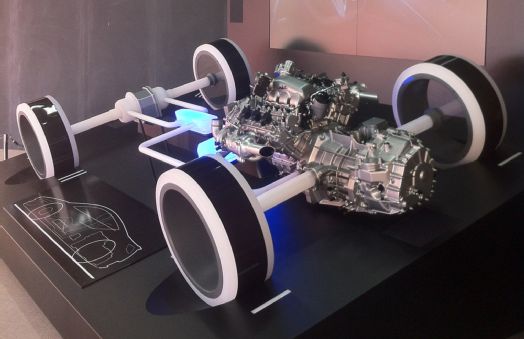Acura NSX Deep Dive: Supercar Gets Big Drivetrain Changes

Acura NSX Deep Dive: Supercar Gets Big Drivetrain Changes
By Scott Evans | November 18, 2013
Read our most recent Acura NSX review.
After numerous teases in the form of renderings and styling bucks, Acura has finally released some key technical details on the upcoming NSX revival, and they’re big changes.
More on Motortrend.com:New Acura NSX to Pace Pikes Peak International Hill Climb
In the biggest shocker, Acura reconfigured the drivetrain from the original NSX’s transverse layout to a longitudinal layout, like a Ferrari 458. Honda R&D executives tell us the switch was made about a year ago after it was decided the transverse arrangement wouldn’t give the car the driving experience the company wanted. The original plan had been to essentially reorient the Acura RLX Sport Hybrid’s drivetrain and add turbochargers. This would move the V-6 engine and transverse transmission with an integrated electric motor to the rear of the car and the two other electric motors to the front. Doing so would save money by using common parts. Apparently, the savings weren’t worth it. Instead, Honda is throwing what must be an enormous amount of money at this car to make it the best it can be.
The new NSX drivetrain retains front-mounted electric motors driving the front wheels independently of one another, as well as a third electric motor integrated in the all-new, Honda-developed transaxle. It’s a dual-clutch unit, though Acura won’t confirm the number of gears, saying only that it will have “more than six.” The RLX Sport Hybrid, for comparison, uses a new seven-speed dual-clutch transmission, and Honda is developing a new eight-speed dual-clutch for cars such as the Accord, though neither is necessarily an indicator of what this all-new transmission will employ. Those same Honda R&D executives tell us the only external change necessary to accommodate the new drivetrain layout was the slight lengthening of the rear end to provide more room for crash structure to protect the drivetrain.
More on Automobilemag.com:2016 Acura NSX to Climb Pikes Peak as Pace Car
Providing power to this new transmission is an all-new V-6 engine about which we were told little. Engineers at the presentation would only say that it is a clean-sheet design and that it will displace “no more than 3.5 liters.” We gleaned a few more details by taking a close look. For starters, this is a wide-angle V-6, not a 60-degree V like other Honda V-6s. It looks to be a 90-degree V-angle, but might be slightly narrower. It features direct injection and has no oil sump — an engineer it will have a dry-sump oil system. To save weight, every bit of this new engine appears to be cast from the absolute minimum amount of metal needed to get the job done.
The new engine is fed by two turbochargers, one hanging off each bank. From the angle of the compressor outlets and the twin throttle bodies mounted on the tall plenum, it appears that the intercoolers will be mounted up high on top of the engine. And it appears that the scoops just behind the doors and below the quarter-windows are functional and will feed these two intercoolers, with hot air exiting through vents in the deck lid flanking the rear window.
More on Automotive.com:Honda Brings Back the S2000 Roadster
The battery, of unknown size and composition, will sit transversely ahead of the engine and behind the seats. Power will be distributed through a module in the tunnel between the seats and sent to or received from the front and rear electric motors. According to video simulations shown by Acura, the NSX will be able to drive under full electric power in the city, but will be effectively front-wheel drive in that scenario, with only the front electric motors powered and the rear drivetrain shut down. Under harder driving, power will come from all three electric motors as well as the gasoline engine.
Acura has so far refused to announce power figures, part of a calculated strategy that speaks to the company’s philosophy on this car. Rather than let the Internet shred the spec chart and make all sorts of numbers-only comparisons, Acura wants people to hear about how the car drives and feels first, then look at the numbers. As such, don’t expect much in the way of hard numbers before the car’s production debut. Still, we know this much: The new RLX Sport Hybrid claims 310 horsepower and 272 lb-ft of torque from its naturally aspirated V-6, and when combined with its three electric motors, the total drivetrain output is 377 horsepower and an unspecified amount of torque. The RLX uses two 27-kW independent electric motors in the rear and a 35-kW electric motor embedded in the transmission. At the bare minimum, we’re certain the NSX will make more total power from its new turbocharged engine and potentially upgraded electric motors. The Ferrari 458, for what it’s worth, makes 557 horsepower and 398 lb-ft of torque.
The NSX’s party trick, though, will be its ability to use regenerative braking with the electric motors to increase performance and handling. Using technology from the RLX Sport Hybrid, the NSX will use its electric motors to drag on certain wheels when cornering in a form of electronic torque vectoring. The independent front electric motors will be able to apply a small amount of regenerative braking to the inside wheel when cornering, slowing it down and changing the car’s inertia while simultaneously accelerating the outside wheel to help steer it around the corner. Because the rear drivetrain uses only a single electric motor powering both rear wheels, it will only be able to apply regenerative braking and not the torque vectoring effect, though it’s possible Acura could use the rear brakes or differential to achieve the same effect.
We’re told Acura’s benchmark in developing the new NSX is the vaunted Ferrari 458 Italia, with Acura hoping to provide a comparable or better driving experience for less money (911 prices, it says) and with more technology. The high-tech powertrain will be augmented by a surprisingly low curb weight that one engineer suggested was targeted at 3200 pounds, though he quickly stopped talking after that. We don’t know much about the NSX’s body and frame construction yet, but Honda confirmed it will be an aluminum monocoque. The Ferrari, by way of comparison, weighs a shade less than 3450 pounds.
Acura has also declined to offer details on the NSX’s suspension, but we expect a fully independent design. Some kind of active damping system is also likely, possibly the variable rate dampers currently employed on the RLX and MDX.
Despite the massive changes to the design and engineering of the car, Honda officials insist that the NSX will be completed in 2015. We’re told the first drivable prototype with the new drivetrain only hit the pavement a month ago, so engineers are likely working around the clock to keep the development on schedule. We’ve also learned that Honda Performance Development, which just recently began working on street applications in addition to racing, is working with the NSX team on a special high-performance model. If Honda’s game plan so far is any indication, we’ll likely see more information on the car released in small doses as the premiere nears.

